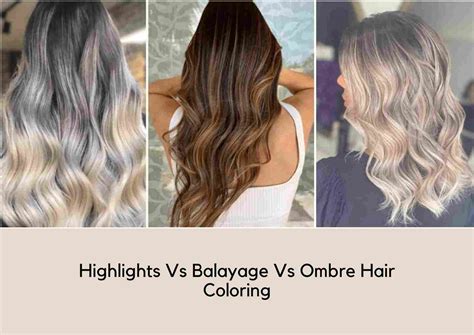Introduction
Balayage and ombre are two popular hair coloring techniques that have been trending in recent years. Both techniques create a natural-looking, gradient effect, but they achieve this look in different ways. In this article, we’ll explore the key differences between balayage and ombre, including the application process, maintenance, and cost.

What is Balayage?
Balayage is a French hair coloring technique that means “to sweep.” It involves hand-painting hair color onto the surface of the hair, creating a subtle, sun-kissed effect. The color is typically applied in a V-shape, starting at the roots and sweeping down to the ends. The result is a natural-looking, blended look with no harsh lines or demarcation.
What is Ombre?
Ombre is a hair coloring technique that creates a gradual transition between two or more shades. The color is applied from the roots to the ends, with the darkest shade at the roots and the lightest shade at the ends. Ombre can be created using any color combination, but it is most commonly seen with natural-looking shades, such as brown to blonde or black to gray.
Key Differences Between Balayage and Ombre
| Feature | Balayage | Ombre |
|---|---|---|
| Application | Hand-painted | Applied from roots to ends |
| Color Blending | Subtle, blended look | Gradual transition between shades |
| Maintenance | Requires less maintenance | Regular touch-ups required |
| Cost | Typically more expensive | Depending on the desired look |
Which Technique is Right for You?
The best hair coloring technique for you depends on your individual hair type, desired look, and maintenance preferences. Here are some general guidelines:
- For a natural-looking, sun-kissed effect: Balayage is a great option.
- For a more dramatic, two-toned look: Ombre is a better choice.
- If you have fine or thin hair: Balayage can add volume and movement to your hair.
- If you have dark hair: Ombre can create a stunning contrast between your roots and ends.
- If you don’t like to get your hair colored frequently: Balayage requires less maintenance than ombre.
Tips and Tricks for Balayage and Ombre
- Use a professional hairstylist: Both balayage and ombre are complex techniques that require a skilled hairstylist to achieve the best results.
- Protect your hair: Both techniques involve lightening the hair, which can damage it. Use a deep conditioner and heat protectant spray to keep your hair healthy.
- Touch up your color regularly: Ombre typically requires touch-ups every 6-8 weeks, while balayage can last up to 12 weeks.
- Experiment with different colors: Both balayage and ombre can be customized to create a unique look for each individual. Experiment with different colors and techniques to find what suits you best.
Common Mistakes to Avoid
- Over-processing: Both balayage and ombre can be damaging to the hair if over-processed. Be sure to follow the instructions of your hairstylist and avoid over-bleaching.
- Unnatural color transitions: The transition between shades in ombre should be gradual and natural. Avoid harsh lines or demarcation.
- Messy application: Balayage and ombre require precise application to achieve the desired look. Avoid sloppy brush strokes or uneven color distribution.
Conclusion
Balayage and ombre are both versatile hair coloring techniques that can create a variety of stunning looks. By understanding the key differences between the two techniques, you can choose the one that best suits your individual hair type and desired look. With proper care and maintenance, your balayage or ombre color can keep you looking your best for months to come.
